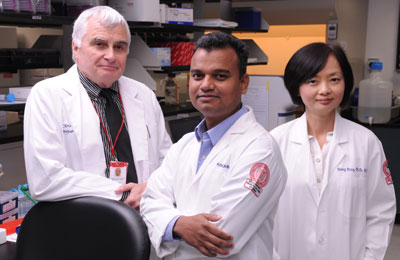
Dr Chris Triggle, Dr Gnanapragasam Arunachalam
and Dr Hong Ding
WCMC-Q sheds light diabetes drug structure
Doha, December 22, 2013
Researchers at Weill Cornell Medical College in Qatar (WCMC-Q) have shed light on the molecular and cellular mechanisms of one of the most widely used diabetes drugs, which have been poorly understood for more than 50 years.
Experiments carried out by researchers in the laboratory of WCMC-Q’s Dr Chris Triggle demonstrate that metformin, the first-choice hypoglycemic drug prescribed to most type-2 diabetes sufferers, interacts with the so-called ‘longevity gene’ SIRT1 to protect the user’s vascular system against deterioration caused by glucose toxicity.
Postdoctoral fellow and lead author of the project, Dr Gnanapragasam Arunachalam, worked with Dr Triggle, professor of Pharmacology, and Dr Hong Ding, assistant research professor of Pharmacology, to produce the study, which has been published online in the prestigious British Journal of Pharmacology.
“Metformin is a very interesting drug that was first introduced in 1958 in the United Kingdom for the treatment of type-2 diabetes. It is comparatively free of significant side effects and unlike most other oral hypoglycaemic drugs lacks a significant risk of producing hypoglycaemia, which itself can also increase cardiovascular risk. Furthermore, the use of metformin is associated with weight loss rather than weight gain – an obvious benefit when many with type-2 diabetes are overweight,” Dr Triggle explained.
“The most common cause of death for diabetes patients is vascular and microvascular deterioration – it’s like an advanced aging of the vascular system – so metformin is an extremely useful drug.”
Dr Triggle said that it has generally been assumed that the beneficial effects of metformin are linked to its ability to inhibit hepatic gluconeogenesis (generation of glucose from non-carbohydrate sources by the liver), which means less glucose in the blood and therefore less vascular deterioration. However, analysis of data from clinical studies of the drug gave Dr Triggle and his team cause to believe a different mechanism was at work.
“We realized some years ago that the reported and generally accepted mechanisms of metformin did not really fit with the pharmacokinetic profile - the way the drug interacts with the body - of the drug. Our study proves that metformin does indeed have a direct protective action on the vasculature,” he said.
Experiments on cultivated mouse cells in the laboratory confirmed that metformin has a direct effect on the vascular function through interaction with a protein called sirtuin 1, which is encoded by the SIRT1 gene, known to play a role in aging. The study was also unusual in that it assessed the effects of the drug at therapeutic clinical concentrations.
Dr Triggle added: “Quite simply, many published studies used a concentration range of metformin that could never be achieved in cells with therapeutic doses nor reflected the ability of the drug to access intracellular compartments. We thus designed protocols that employed more realistic concentrations of metformin. That the vascular metformin requires sirtuin 1 is particularly noteworthy, as this protein has been linked to a protective role against metabolic disease associated with premature ageing.”
In non-mammalian species such as yeast and nematodes, the homologous gene of SIRT1 is Sir2, which has also been associated with anti-ageing and longevity.
The findings of the recently published study have now been extended by Dr. Ding and were considered significant enough for her to be invited to make a poster presentation to the British Pharmacological Society, and a potential audience of 500, at the organization’s winter meeting, held recently in London.
Dr Triggle concluded: “Our publication not only enhances our knowledge of how treatment with metformin reduces cardiovascular risk in patients with type-2 diabetes, but also provides a potential target for new therapeutic entities that can mimic metformin’s action on sirtin1.” – TradeArabia News Service







